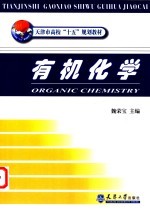图书介绍
有机化学pdf电子书版本下载

- 魏荣宝主编 著
- 出版社: 天津:天津大学出版社
- ISBN:756181819X
- 出版时间:2003
- 标注页数:340页
- 文件大小:26MB
- 文件页数:351页
- 主题词:有机化学-高等学校-教材
PDF下载
下载说明
有机化学PDF格式电子书版下载
下载的文件为RAR压缩包。需要使用解压软件进行解压得到PDF格式图书。建议使用BT下载工具Free Download Manager进行下载,简称FDM(免费,没有广告,支持多平台)。本站资源全部打包为BT种子。所以需要使用专业的BT下载软件进行下载。如 BitComet qBittorrent uTorrent等BT下载工具。迅雷目前由于本站不是热门资源。不推荐使用!后期资源热门了。安装了迅雷也可以迅雷进行下载!
(文件页数 要大于 标注页数,上中下等多册电子书除外)
注意:本站所有压缩包均有解压码: 点击下载压缩包解压工具
图书目录
第1章 概述(conception) 1
1.1 有机化合物的一般特点(characteristics of organic compound) 1
1.2 共价键的属性(feature of covalent bond) 1
1.3 有机化合物的分类(classification of organic compound) 3
第2章 有机化学的基础知识(basic knowledge of organic chemistry) 4
2.1 简单有机化合物的命名(nomenclature of simple organic compound) 4
2.1.1 烷烃的命名(nomenclature of alkane) 4
2.1.2 环烷烃的命名(nomenclature of cycloalkane) 6
2.1.3 烯烃的命名(nomenclature of alkene) 8
2.1.4 炔烃的命名(nomenclature of alkyne) 9
2.1.5 二烯烃的命名(nomenclature of diene) 9
2.1.6 卤代烃的命名(nomenclatureof halo-hydrocarbon) 10
2.1.7 醇的命名(nomenclature of alcohol) 10
2.1.8 酚的命名(nomenclature of phenol) 11
2.1.9 醚的命名(nomenclature of ether) 11
2.1.10 简单醛、酮、羧酸、酰卤、酸酐、酯、酰胺、胺类的命名(nomenclature of aldehyde,ketone,carboxylic acid,acyl halide,anhydride,ester,amide and amine) 12
2.2.3 氧化数法确定有机基团顺序大小(determination of sequence of organic group by exidation number) 13
2.2.2 氧化数(oxidation number) 13
2.2 广义氧化还原理论(theory of generalized oxidation and reduction) 13
2.2.1 电负性(electronegativity) 13
2.3 广义酸碱理论(theory of generalized acid-base) 14
2.3.1 无机化学的酸碱概念(conception of acid-base in inorganic chemistry) 14
2.3.2 酸碱的质子理论(proton-theory of acid-base) 15
2.3.3 酸碱的Lewis理论(Lewis theory of acid-base) 16
2.3.4 软硬酸碱理论(theory of soft and hard acid-base) 16
2.4 有机化合物中碳的构型(configuration of carbon in organic compound) 17
2.4.1 sp3杂化与四面体构型(sp3 hybridization and tetrahedral configuration) 17
2.4.3 sp杂化与线状构型(sp hybridization and linear-configuration) 19
2.4.2 sp2杂化与平面构(sp2 hybridization and plane-configuration) 19
2.4.4 sp3、sp、sp杂化与d2 sp3、dsp2杂化的构型(configuration of sp3,sp2,sp and d2 sp3,dsp2 hybridization) 20
2.5 共振论与分子轨道理论(resonance and molecular orbital theory) 21
2.5.1 共振论(resonance theory) 21
2.5.2 共振论在有机化学中的应用(resonance theory in organic chemistry) 22
2.5.3 分子轨道理论(molecular orbital theory) 23
2.6 手性化合物与手性合成(chiral compound and chiral synthesis) 24
2.6.1 平面偏振光(plane polarized light) 24
2.6.2 旋光性、旋光物质与比旋光度(optical rotation,optical substance and specific rotation) 25
2.6.3 分子的对称性(molecular symmetry) 25
2.6.4 手性分子(chiral molecule) 27
2.6.5 含一个手性碳的构型表示式与标记(determination configuration for one chiral-carbon) 28
2.6.6 含有两个手性碳原子的旋光异构(optical isomer for two chiral-carbon atoms) 31
2.6.7 环状手性化合物(chiral cyclo-compound) 32
2.6.8 不含手性碳原子的光学异构体(optical isomer for compound contained no chiral-carbon atoms) 33
2.6.9 外消旋体的合成与拆分(synthesis and separation for racemic modification) 36
2.6.10 Cram规则(Cram's rule) 37
阅读材料之一 手性催化剂和手性药物简介 38
2.7 有机化合物的波谱简介(introduction of organic compound spectra) 39
2.7.1 红外光谱(infrared spectra) 39
2.7.2 核磁共振nuclear magnetic resonance) 46
2.7.3 碳13核磁共振谱(13CNMR) 49
2.8 绿色化学与环境(green chemistry and environment) 49
习题(problem) 54
第3章 烃类(hydrocarbon) 58
3.1 烷烃与环烷烃(alkane and cycloalkane) 58
3.1.1 烷烃的物理性质(physical property of alkane) 58
3.1.2 烷烃的构像(conformation of alkane) 61
3.1.3 环烷烃的构象(conformation of cycloalkane) 63
3.1.4 烷烃的化学性质(chemical property of alkane) 66
3.1.5 武尔兹反应(Wurtz reaction) 69
3.1.6 烷烃的来源(source of alkane) 70
阅读材料之二 可燃“冰”——新的绿色能源 70
阅读材料之三 汽油的辛烷值 71
习题(problem) 71
3.2 不饱和烃(unsaturated hydrocarbon) 72
3.2.1 不饱和烃的分类及结构特征(classification and stmctural feature of unsaturated hydrocarbon) 72
3.2.2 不饱和烃的物理性质(physical property of unsaturated hydrocarbon) 73
3.2.3 亲电加成反应(electrophilic addition reaction) 74
3.2.4 亲电加成反应的机理(mechanism of electrophilic addition reaction) 79
3.2.5 马氏加成与反马氏加成(Ma's and anti-Ma's addition) 81
3.2.6 加氢反应(hydrogenation) 83
3.2.7 α-氢的反应(reaction of α-hydrogen) 84
3.2.8 氧化反应(oxidation) 84
3.2.9 溴化氢的自由基加成及机理(free radical addition and mechanism of hgdrogen bromide) 85
3.2.10 亲核加成(nucleophilic addition) 86
3.2.11 炔氢的反应reaction with contained terminal alkyne hydrogen) 86
3.2.12 共轭二烯烃的1,2-加成与1,4-加成反应(1,2 and 1,4 addition reaction of conjugated diene) 87
3.2.13 聚合反应(polymerization) 88
3.2.14 诱导效应(inductive effect) 90
3.2.15 共轭效应与超共轭效应(conjugative and super conjugative effect) 91
3.2.16 环加成与电环化反应(cycloaddition and electrocyclic reaction) 93
3.2.17 烯烃的制备(preparation of alkene) 97
3.2.18 不饱和度的计算和测定(determination and calculation of unsaturated value) 98
习题(problem) 99
3.3 芳香烃(aromatic hydrocarbon) 103
3.3.1 芳香烃的物理性质(physical property of arene) 103
3.3.2 苯的结构(structure of benzene) 107
3.3.3 苯环上的亲电子取代反应(electrophilic substitution on benzene ring) 108
3.3.4 苯环上的定位效应(orientation on benzene ring) 115
3.3.5 芳烃的来源及制法(source and preparation of arene) 120
3.3.6 苯环上的亲核取代反应(nucleophilic substitution on benzene ring) 121
3.3.7 苯环上的加成反应(addition reaction on benzene ring) 123
3.3.8 苯环上侧链的反应(reaction of branched chain of benzene ring) 124
3.3.9 多环芳烃(polycyclic arene) 125
3.3.10 富勒烯(fullerenes) 136
3.3.11 芳香性、非芳香性及反芳香性(aromaticity,non-aromaticity and anti-aromaticity) 137
阅读材料之四 苯并芘 138
习题(problem) 139
4.1 卤代烃(halo-hydrocarbon) 145
第4章 烃的衍生物(derivative of hydrocarbon) 145
4.1.1 卤代烃的分类(classification of halo-hydrocarbon) 146
4.1.2 卤代烃的物理性质(physical property of halo-hydrocarbon) 146
4.1.3 卤代烃的化学性质(chemical property of halo-hydrocarbon) 146
4.1.4 卤代烃的制备(preparation of halo-hydrocarbon) 163
4.1.5 重要的有机卤化物(important organo-halide) 165
4.1.6 有机卤化物分析(analysis of organo-halide) 168
阅读材料之五 奇妙的冷冻杀虫剂 168
习题(problern) 169
4.2.1 醇(alcohol) 171
4.2 含氧化合物(contained oxygen compound) 171
阅读材料之六 神奇的超临界水 181
4.2.2 酚(phenol) 182
4.2.3 醚(ether) 190
阅读材料之七 飞秒化学 195
习题(problem) 197
4.2.4 醛、酮、醌(aldehyde,ketone,quinone) 201
阅读材料之八 甲醛与人体健康 228
习题(problem) 230
4.2.5 羧酸(carboxylic acid) 233
习题(problem) 244
4.2.6 羧酸衍生物(derivatives of carboxylic acid) 247
阅读材料之九 环境激素 262
习题(problem) 264
4.3 含氮化合物(contained nitrogen compound) 268
4.3.1 硝基化合物(nitro-compound) 268
4.3.2 胺类(amines) 273
4.3.3 重氮和偶氮化合物(diazonium and azo-compound) 285
4.3.4 多元胺(poly-amine) 290
4.3.5 禁用染料(prohibitive dyes) 290
阅读材料之十 亚硝胺 291
4.3.6 氨基的分析(analysis of amino group) 291
习题(problem) 293
4.4 杂环芳烃(hetrocyclic aromatic hydrocarbon) 295
4.4.1 分类和命名(classification and nomeclature) 296
4.4.2 杂环化合物的结构(structure of hetrocyclic compound) 297
4.4.3 杂环化合物的性质(property of hetrocyclic compound) 298
4.4.4 杂环化合物的应用(application of hetrocyclic compound) 306
阅读材料之十一 神奇的索烃 307
习题(problem) 308
5.1.2 单糖(monosaccharide) 310
5.1.1 糖的分类(classification of saccharide) 310
第5章 天然有机化合物(natural organic compound) 310
5.1 碳水化合物(carbohydrate) 310
5.1.3 二糖(disaccharide) 317
5.1.4 多糖(polysaccharide) 318
5.2 氨基酸和蛋白质(amino-acid and protein) 319
5.2.1 氨基酸的结构和物理性质(structure and physical property of amino-acid) 320
5.2.2 氨基酸的化学性质和制法(chemical property and preparation of amino-acid) 320
5.2.3 蛋白质(protein) 323
阅读材料之十二 明星分子NO的功与过 324
阅读材料之十三 瘦肉精 326
5.3 蜡和油脂(wax and oil) 327
5.4 甾体化合物(steroid) 328
5.5 生物碱(alkaloid) 329
5.6 萜类(terpene) 331
阅读材料之十四 关爱生命,远离毒品 332
习题(problem) 334
常用词汇中英文对照表 336
参考文献 340